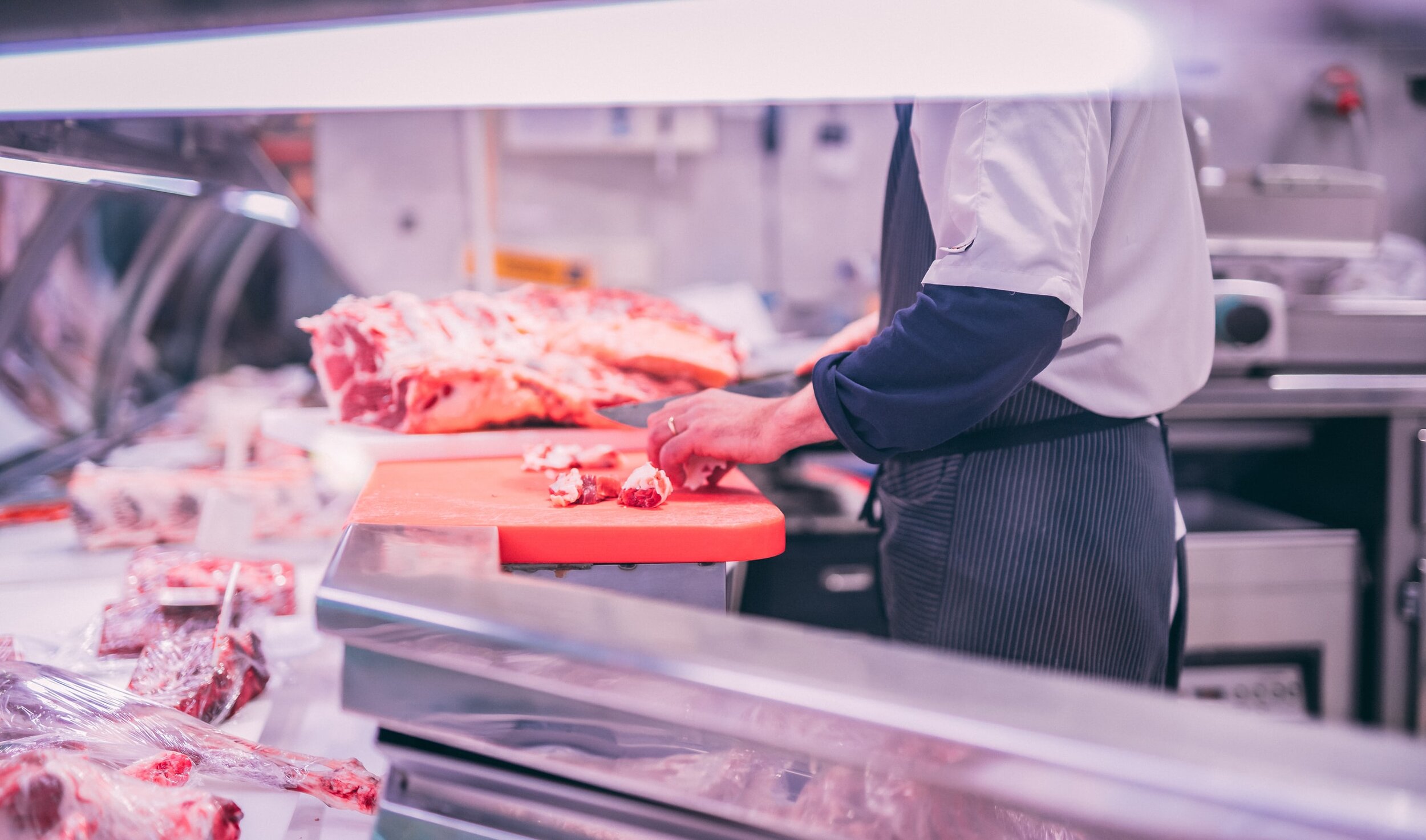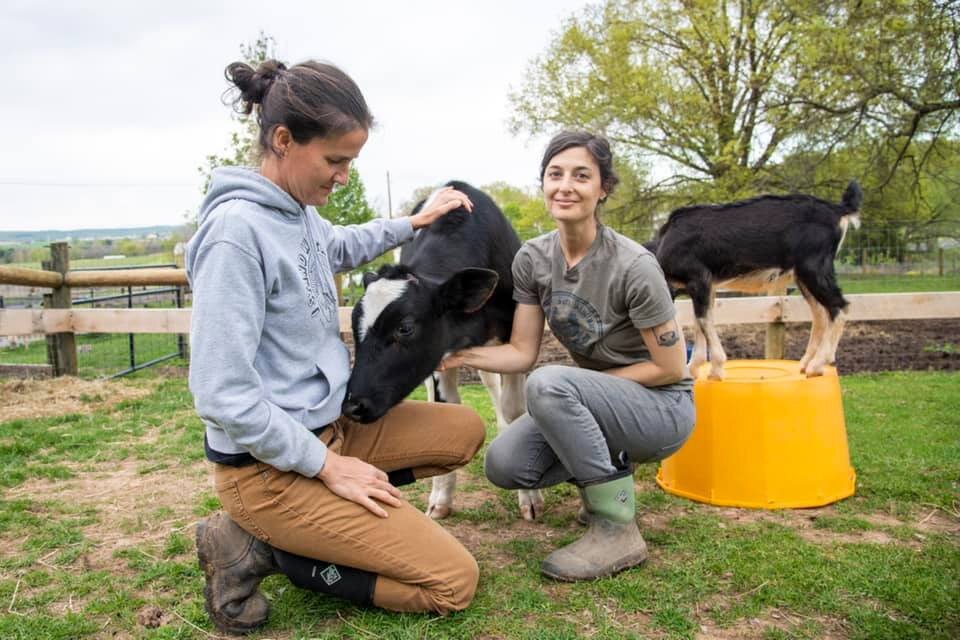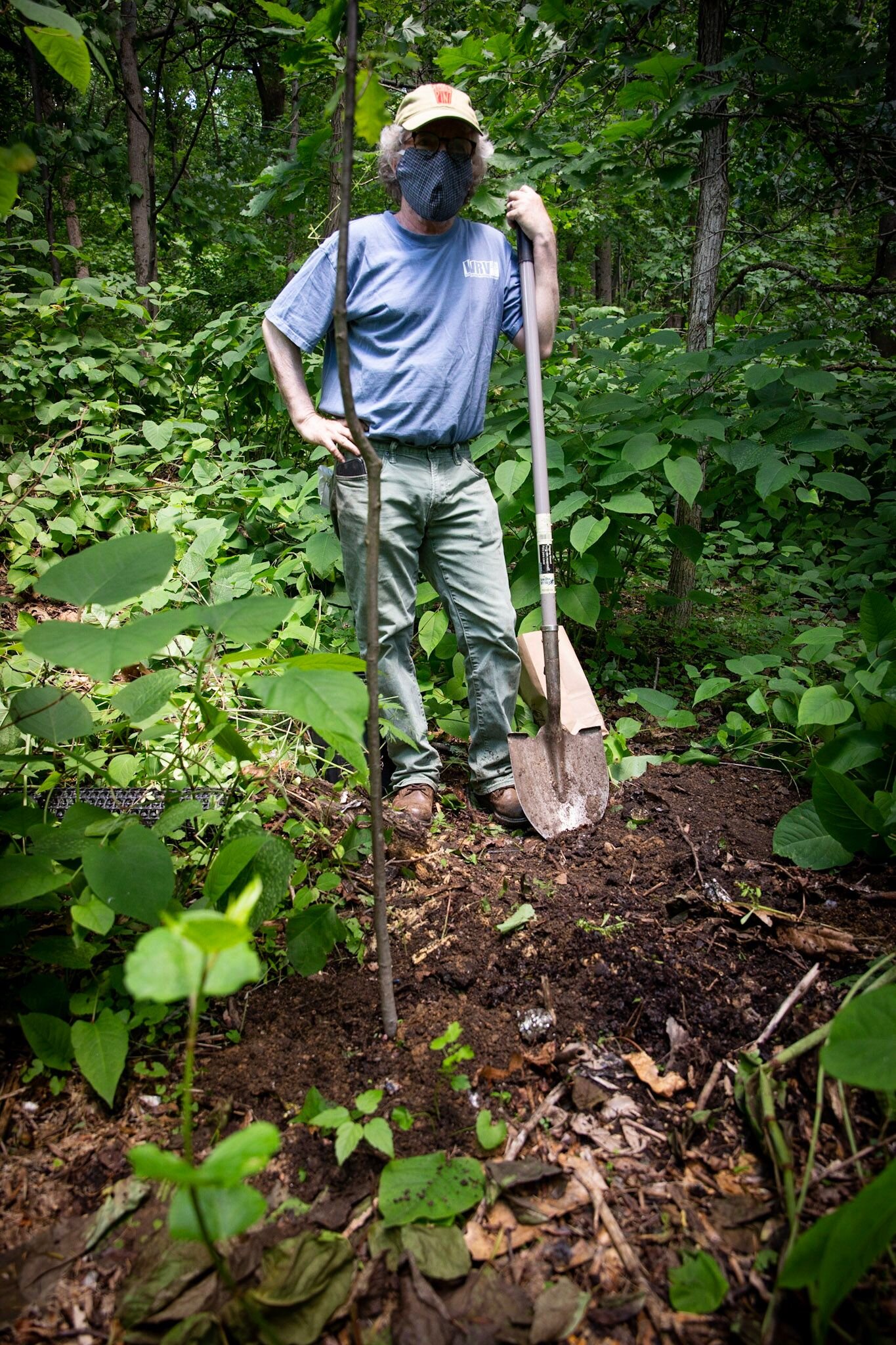Photograph courtesy of Unspalsh.com
Meat your Maker
By: Siobhan Gleason
JBS meatpacking worker Carmen Dominguez is concerned about her co-workers’ health during COVID-19. Her colleagues Wilbert Rivera and Enock Benjamin died from COVID-19 this April after 19 workers at the Souderton, Pennsylvania plant tested positive for the virus. Dominguez felt it was important to speak to the media about her experience. Her interview with Grid Magazine was translated by United Food and Commercial Workers Local 1776 union representative Jose Ortiz. (Dominguez is a union steward for UFCW and her coworkers in the JBS beef packing plant are members of the UFCW as well.)
“We need to share the real life that we are living,” Dominguez says. “People have no idea what we are living every day to make sure they have food on the table.”
According to a Centers for Disease Control and Prevention report, 4,913 workers in meat and poultry processing plants across the United States tested positive for COVID-19 this April. Meat packing plants are hotbeds for sickness even under normal circumstances. According to the US Bureau of Labor Statistics, the 2015 rate of illness for full-time meat packing workers was 10 times higher than the illness rate in the private sector.
On April 2, the JBS plant closed temporarily to stop the spread of COVID-19. Cramped conditions in meat packing plants often require workers to be in close proximity, which can cause viruses to spread with lightning speed. Many other plants across the country also closed as their workers fell ill.
Dominguez felt it was necessary to share her experience in the JBS plant after her co-workers died. She wrote an opinion piece for The New York Times on April 29 to honor her co-workers and to explain just how physically taxing meat packing work is.
Dominguez and her coworkers must work in extreme heat in the slaughterhouse and extreme cold in the freezer. These temperature changes can exacerbate health conditions. There is also an element of unpredictability in the JBS beef packing plant. Workers can never predict what they need to do each day.
“Every single day will be different. We need to be prepared for what is going to happen that day,” Dominguez says. “It’s not simple.”
In response to the wave of closures, President Trump ordered all meat packing plants to reopen on April 28. He used the Defense Production Act to keep the plants open by classifying them as critical infrastructure.
Carmen Dominguez —Photograph courtesy of Carmen Dominguez
On April 20, the JBS Souderton plant had already reopened with new health procedures to limit the spread of COVID-19, which were put in place by Dr. Rachel Levine. Dominguez believes the procedures are strict, but necessary.
“Right now we’ve tried to implement social distancing, masks, face shields. We make sure to educate people to wash your hands,” Dominguez says. There are signs throughout the plant reminding workers of these protective measures. The JBS workers are reminding each other to follow the procedures, which has become an extra part of their jobs. JBS has not yet responded to a request for comment from Grid Magazine for this article.
Dominguez believes it may be necessary to keep these procedures in place after COVID-19 is no longer a threat. “I was thinking that is the only way we can prevent [outbreaks] in the future,” Dominguez says.
Though customers may not have seen the spread of COVID-19 between meat packing workers and the subsequent plant closures, they have seen the shortages of meat at grocery stores across the United States. These shortages are a direct result of plant closures.
According to the National Farmers Union, four meat processing companies — Cargill, Tyson, JBS, and National Beef Packing Co — control 85% of the beef industry in the United States. These companies are some of the most commonly seen brands at the store, with the exception of JBS. JBS products are often marked with a store brand, rather than a JBS logo. Due to the domination these companies have of the meat industry, any issues at the processing plants can have large effects on the economy.
Though there have been meat shortages at grocery stores, the livestock and poultry in concentrated animal feeding operations, or CAFOs, continue to need space and food. The United States Department of Agriculture defines CAFOs as agricultural organizations that raise animals in confined areas, such as indoor environments. CAFOs have more than 1,000 beef cattle, 700 dairy cows, 2,500 pigs weighing more than 55 pounds, 125,000 broiler chickens or 82,000 hens confined for more than 45 days per year.
The waste produced by animals inside CAFOs has presented ongoing environmental problems. CAFOs often produce far more manure than can be used for farming or crops. Manure produced by CAFOs contains ammonia, nitrogen, and phosphorus, which can cause algal blooms when manure washes into nearby waterways, killing fish and other animals. According to a fact sheet from the Chesapeake Bay Foundation, about 35% of Pennsylvania phosphorus pollution in the Chesapeake Bay is caused by manure runoff.
The high number of animals in CAFOs keep meat from ever running low, but also require animals to be slaughtered constantly. Plant closures have presented a problem. Animals continue to give birth and eat, but there are not enough workers to process them for sale. Workers have been forced to cull many farm animals so that there are not too many animals in one space.
The animal rights group Direct Action Everywhere recently created a campaign to fight back against what they consider to be violent culling methods. These methods include shutting down ventilation where farm animals are housed, which causes animals to suffocate.
Judy Wicks, a leader in the local food movement and founder of the White Dog Cafe, believes the need for culling is a symptom of the larger problems with CAFOs and factory farming. The pandemic “has exposed weaknesses in an industrial food system. Now we see that we cannot rely on this industrialized food system,” Wicks says.
In addition to chickens, pigs are also being culled across the country. “When the pigs are larger than a certain size they can’t be processed in the slaughterhouse. They’re too big for the conveyor belt,” Wicks says. According to The Guardian, about 2 million animals have been culled on American farms so far.
Animal rights groups argue that the mass culling of animals is just one aspect of the daily mistreatment of animals across many farms.
Liberation Philadelphia is one such group. Since its founding in 2017, Liberation Philadelphia has been spreading awareness about animal mistreatment.
“Our goal was to create an organization that’s bringing a community of vegans together and hopefully create activists out of them,” activist Mansi Bhagwate says.
Members of Liberation Philadelphia have participated in various demonstrations to push back against slaughterhouses. “We do disruptions inside grocery stores. We do protests outside slaughterhouses,” Bhagwate says.
One focus for Liberation Philadelphia has been live animal markets across Philadelphia, where customers can buy individual chickens, ducks, rabbits, and other animals which are slaughtered on site. Bhagwate and other activists have freed several hens from live markets. One of the hens that was brought to an animal sanctuary later died from reproductive tumors. “Imagine somebody buying her and eating her. She has reproductive tumors, so you’re actually eating those. That’s really not healthy,” Bhagwate says.
Animal sanctuaries often have a close relationship with activists like Bhagwate. “There is a lot of collaboration,” Sarah Salluzzo, executive director and co-founder of Lancaster Farm Sanctuary, says. Lancaster Farm Sanctuary is a nonprofit farm animal sanctuary in Elizabethtown, Pennsylvania.
Lancaster Farm Sanctuary founders Sarah Salluzzo and Jonina Turzi. Photograph by Jennifer Foster, courtesy of Lancaster Farm Sanctuary
Activists often reach out to sanctuaries to find a home for animals, but finding the space for rescued animals can be a challenge. Lack of space is the reason why Lancaster Farm Sanctuary is moving to a new area 2 miles from their current location in June. More land will allow them to house a greater number of animals, but lack of space will always be a problem.
Animal rights activists share “many social media pages where people post ‘looking for a home.’ If someone reaches out to us, we will try to find placement,” Salluzzo says, “but it’s impossible to find placement for everyone.”
The lack of space in sanctuaries raises the question — why are there so many animals in CAFOs? Is raising an abundance of farm animals in a cramped space the most profitable way to farm?
For farmers, not necessarily.
Many CAFO operations are not fully owned by farmers. Farmers have to supply their own structure to hold the animals, but all animals and feed are supplied by outside companies, or vertical integrators. The farmers work as contract growers, rather than employees. Once the animals have grown, the farmers sell the animals back to the vertical integrators and receive their pay.
Under this system, farmers have no ownership over the feed and animals. If farmers receive sickly chickens or poor feed, they may be paid less if their chickens die or do not grow large enough. Farmers are then paid a bonus based on how superior their chickens are compared to other contract farmers working with the same vertical integrator. This is called a tournament ranking system.
US Representative Ro Khanna, of California’s 17th District, decided that unfair practices like the tournament ranking system needed to be fought at the federal level. In May he introduced a companion to Cory Booker’s Farm System Reform Act for the House of Representatives, which he believes will give farmers more power.
“These tournaments that people have to enter into often don’t compensate them appropriately. They are not giving farmers control of their own destiny,” Khanna says.
The control vertical integrators have over animal production can be felt by independent farmers, who struggle to find anyone to buy animals from them.
“As an independent hog farmer you can’t call up the giant meatpacking plant and say ‘what will you give me for my 30 hogs?’ They have no interest in your hogs because they’re slaughtering their own hogs,” Krissy Kasserman, factory farm organizing manager at Food & Water Watch says. “As an independent hog farmer in the Midwest now you might need to drive eight or 10 hours to find a slaughter facility to take your hogs.”
The control companies have over the market has put farmers out of business. According to the United States Department of Agriculture, Pennsylvania has lost more than 6,000 farms between 2012 and 2017. Meanwhile, the average farm size has increased. Between 2011 and 2019, the average farm size in Pennsylvania has increased by 16 acres.
Khanna and Kasserman believe the federal government can end the dominance of vertical integrators.
The Farm System Reform Act would place an immediate moratorium on new CAFOs and would not allow existing CAFOs to expand. Corporate integrators, rather than contract farmers, would be held responsible for pollution caused by CAFOs. Voluntary buyouts would give farmers the ability to transition out of operating CAFOs. The bill would also strengthen the Packers & Stockyards Act, which would prohibit the use of tournament ranking systems and would give farmers protection from predatory purchasing practices.
“When Congress funds it, it will be giving farmers the opportunity to leave and become [self] sufficient,” Khanna says.
Food & Water Watch was the first national organization to call for a ban on factory farms in 2018. Kasserman and her colleagues are working towards bills in Pennsylvania, Oregon, Iowa, Maryland, and New Mexico to create state-level moratoria on factory farms. She believes that support for the Farm System Reform Act is growing due to the current breakdown in the consolidated agriculture system and the recent wave of illness among meat packing workers.
“The campaign has taken off quickly. It seems now our life circumstances have evolved to meet the moment this bill was designed for,” Kasserman says.
Though the Farm System Reform Act aims to empower farmers, citizens can also do their part to support independent farmers in the current moment.
Shopping directly from farmers is always a good option. A tool that may help shoppers find products supplied by local farmers is the “Guide to Finding Local Food during Pandemic,” which can be found on the All Together Now Pennsylvania website. Local farmers who would like to be added to the list can contact info@alltogethernowpa.org. Wicks has been putting the resource together.
“I’m compiling an ongoing list,” she says.
Blue Rooster Farm in East Waterford Pennsylvania is one independent farm that has been in operation for 22 years. Julie Hurst and her husband Roy Brubaker raise cows, hogs and sheep, which are all humanely raised. The beef cows and sheep are grass-fed and pasture raised and no animals receive synthetic growth hormones. Blue Rooster Farm sells a wide selection of meat options for customers which includes the option of a quarter, half or whole beef.
Hurst has noticed an increase in demand for meat products from her customers during the pandemic.
“I think people are scared,” Hurst says. “There’s enough people worried about whether or not they’d be able to get meat at the grocery store.”
Local farmers are worth supporting because most farm on a much smaller scale compared to CAFOs. Many local farmers like Hurst also use sustainable farming practices.
According to Jacqueline Ricotta, professor of Plant Science at Delaware Valley University, sustainable farming is sustainable in three ways: environmentally, economically, and socially. This means that sustainable farming has positive effects on local communities, workers’ wages, and the health of the environment. Independent farms work towards balancing these three areas much more than a CAFO worker could ever hope to.
“Agriculture touches everyone’s lives and we want it to be as positive an endeavor as it absolutely can be,” Ricotta says.











